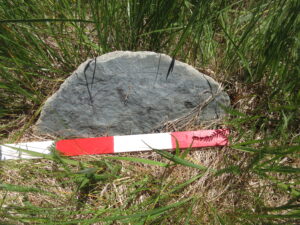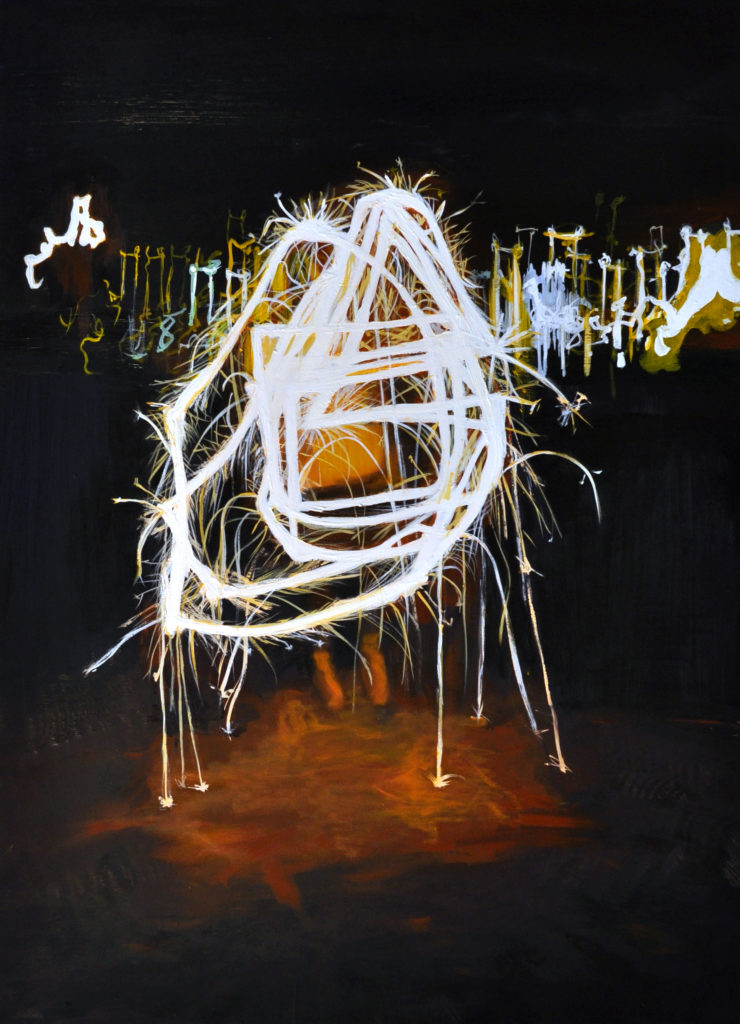Small, modest markers of love and respect: field stones in Newfoundland’s cemeteries, by Robyn S Lacy
July 2023
When you walk through a cemetery in Newfoundland, you reach out your hand to brush through the tall grass or pick a partridgeberry that has grown plump, snuggled between the leaves and mosses. You might rest your fingers on the tops of old gravestones, made of sandstone or marble, and pause to read the names of those early Newfoundlanders, planted long before your time. Passing between the gravestones, your foot hits a small, rounded stone tucked under the grass, and you kneel to brush it clear. As you do, you notice more small stones dotted along the rows. What are they? Some have squared tops, some rounded, with no words or dates carved into their faces, all set into the cemetery’s crooked rows.
We call these ‘field stones’, gravestones made of locally collected stone, shaped into a rough gravestone, and placed into the ground at the head and sometimes foot of their graves, to mark the place of burial. These little markers don’t usually have inscriptions on them, and when they do, they often don’t have more than initials, a name, or a date. They are chosen to mark graves of people who may have been illiterate, by people who could not afford a more professionally carved stones, or when people could not access more elaborate stones.
Throughout Newfoundland’s burial spaces, field stones can be seen everywhere. Once you know what to look for, they will jump out of the grass at you. Before the highways were constructed, outport communities were relatively disconnected from one another by land. Through the 18th century into the early 19th, if you wanted an inscribed gravestone for your loved one, you had to order it from the British Isles. These imported stones were made from limestone and were carved overseas, shipped across the Atlantic on sailing ships, and delivered to outports like Port de Grave and Trinity, where you can see amazing examples of limestone gravestones today. But for many Newfoundlanders, this was far too expensive.
In the 19th century, gravestone carvers began setting up shop in St John’s, with familiar names like Alexander Smith, J Hay, and Muir, who all established premises in the downtown area. These carvers used local sandstone, and eventually imported white and grey marble from the United States. Still, these stones were often financially inaccessible to some families. Field stones offered a feasible alternative them to mark the graves of their loved ones, to show that respect for their place of burial and be able to revisit their grave in the future, with something tangible and visible on the landscape.
Field stones will outnumber the traditional inscribed gravestones at many sites. If you visit St Augustine’s Anglican Cemetery #1, a historic site in New Perlican, the first thing you might notice, after the goats working diligently to clear the ground of overgrowth, are the depressions near the entrance, marked in a neat row with short, uninscribed field stones. As you notice them, more and more jump out, and recent research at the site have identified 373 field stones throughout the site. St Augustine’s, which opened between 1892 and 1895, is scattered with upright stones, but these are significantly outnumbered by the small, modest field stones.

It’s important to recognize field stone’s importance in our burial landscape in the province. In many communities, with no other option available for a gravestone, they were widely emplyeded, but today it is often difficult for people to tell whether a rock is marking a grave or not. Because of this, field stones have often been removed from historic cemeteries. People may think they are only natural rocks in the field and pull them out in order to maintain the grass or remove tripping hazards for visitors, but in fact removing these stones takes away what is often the only marking of someone’s grave, long dead. No one means to, but field stones are easy to overlook.
There has been relatively little research into field stones in Newfoundland, but they have been in use since the 18thcentury, likely earlier, through the 20th century. They are typically sourced from nearby caches of slate, shale, or a sandstone, square or rounded on the top, with a flat face and back. Often, you can see marks on the top of the stone from the chisel used to shape the stone, an enduring, unique connection to the carver. The stones are set into the ground such that you can usually see these layers in their sides. That is a good indicator that it isn’t naturally occurring but was placed there for a purpose.
In North America, we have the idea that the grave is an eternal resting place, and wanting those places identified for visitors in the future goes hand in hand with that. Uninscribed field stones, their blank faces looking back at you across the cemetery, were placed at the head of the grave with no less tenderness and love than an ornate monument. The next time you’re out walking in a rural cemetery in Newfoundland, have a careful look around for field stones, and take a moment to think about all the people who lived and worked in the land and sea around you.
Robyn S Lacy is working towards a PhD in historical archaeology at Memorial University of Newfoundland. She also runs Black Cat Cemetery Preservation with her husband, working to preserve historic gravestones in the province. Her research focuses on 17th-century burial grounds and landscapes in North America, and she is currently working on her second book which explores protective magic and graves. You can find out more about her research at www.spadeandthegrave.com or on twitter @graveyard_arch
References:
Lacy, Robyn S
2022 PhD Fieldwork 3: Surveying Field Stones at St Augustine’s Cemetery 1. Spade & the Grave. May 4, 2022. Online article: https://spadeandthegrave.com/2022/05/04/phd-fieldwork-3-surveying-field-stones-at-st-augustines-cemetery-1/
Pocius, Gerald
1981 Eighteenth- and Nineteenth-century Newfoundland Gravestones: Self-Sufficiency, EconomiSpecialization, and the Creation of Artifacts. Material Culture Review, Volume 12 (Spring): 1-16.
1986 The Transformation of the Traditional Newfoundland Cemetery: Institutionalizing the Secular Dead. Material Culture Review, Volume 23, Spring 1986: 25-34.



